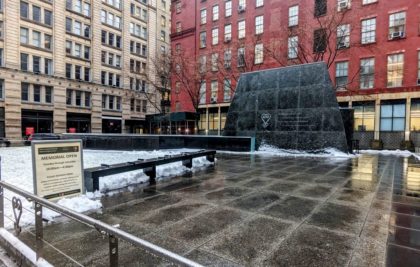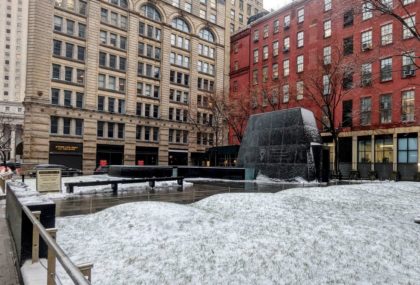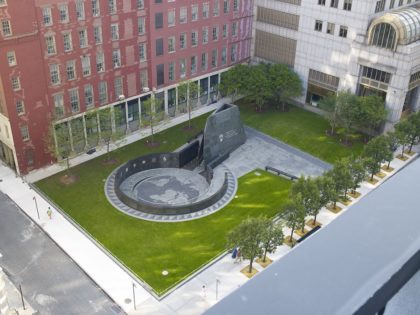Non-profit founded for African Burial Ground
I’ve been fixated on the African Burial Ground National Monument on Duane for a couple years now — mostly because it is amazing and yet it has been closed permanently since August 2022, and often closed before that, without any warning, I’ve hounded the National Parks Service press office, emailed the monument itself, and even followed up with local congressmen, until finally a break-through: Congressman Dan Goldman sent a press release saying that a non-profit had been founded to support the monument.
Rodney Leon, the architect who designed the site in 2005, has created the 501 c3 — African Burial Ground Memorial Foundation — to help advocate for the site and raise funds where the federal government falls short, as it has done recently. But it’s not going to be easy starting from scratch.
“I am hoping to accelerate efforts for repair and maintenance,” said Leon, whose work includes a permanent memorial to the victims of the Transatlantic Slave Trade at the UN. “It is a challenge, especially with changes in administration and funding priorities at the National Park Service. The superintendent is now in charge of nine or 10 sites. And we are competing with places like the Statue of Liberty.”
The site itself is amazing: intact human skeletal remains were discovered by an archeological team 30 feet below the street level during the excavation for the federal office tower at 290 Broadway in 1991. (At the time we had a Black mayor, David Dinkins, which was its own rare occurrence.) It soon became clear that they had unearthed part of the “Negroes Buriel Ground”- shown on historical maps as a six-acre burial ground that was thought to once contain upwards of 15,000 remains of enslaved and free Africans who lived and worked in colonial New York from the 1630s to 1795.
Until the excavation, the site was paved over as a municipal parking lot.
The memorial now sits on just a fraction of that six-acre site and contains the remains of 419 free and enslaved Africans found while archeologists surveyed the site in the early ’90s.
Leon created three distinct areas: the ancestral chamber, the black marble structure that resembles the hold of a ship; the circle of the diaspora, an amphitheater-type area depressed into the ground; and the seven ancestral mounds, which contain the remains, each in hand-carved coffins.
The deferred maintenance in recent years includes fractures along the foundation of the chamber — which is the reason the memorial is closed — and issues with the lighting, as well as maintenance needs for the water filtration system and stone work. In the meantime, the Parks Service has directed visitors to the visitor center on Broadway, but most people don’t even know that is there. (The website says a structural engineer was due to assess the situation in 2022.)
Meanwhile, the sandwich board outside the memorial gives opening hours, yet a chain keeps visitors out.
“There is some irony that the memorial is not accessible during Black History Month,” Leon noted. “That made me realize that I needed to be more active.”
It makes me sad and frustrated that the federal government can’t support a cultural resource such as this, and instead pushes the burden onto the private sector. But I can’t think of a better cause.

















For almost 30 years, that section of Duane Street was the view from my window. I watched as the buildings that were there be demolished, all the way to final construction of both 290 Broadway and the completion of the African Burial Ground. (There was never a municipal parking lot there.) GSA knew that there were bodies buried there. I think they thought they would get away with avoiding the situation, but it didn’t work out that way for them. So the construction plan had to be amended. So it’s not surprising that this situation has evolved to what it is today. It was simply not a part of the original plan. Very sad.
Thank you for following and highlighting this important story and ongoing situation. I have always felt a sense of deep reverence, fondness and respect for this site and for how it was miraculously saved and honored, against all odds. It is shameful how it has just been left in a state of neglect and willful disrepair, after the long fight to save and sanctify this ground in the first place. The disrespect this illustrates unfortunately tracks with it’s nearly 400 year history of marginalization, exclusion and erasure. I agree that it is never good when the federal government cannot meet its duties to not simply create a monument but to maintain it in perpetuity. It should not be the role of private donor or people of good will. It is a public good. Especially in this case, when so few traces of the presence and existence and life and death of New York’s non-European and truly diverse early population have escaped oblivion and been deleted from the narrative.